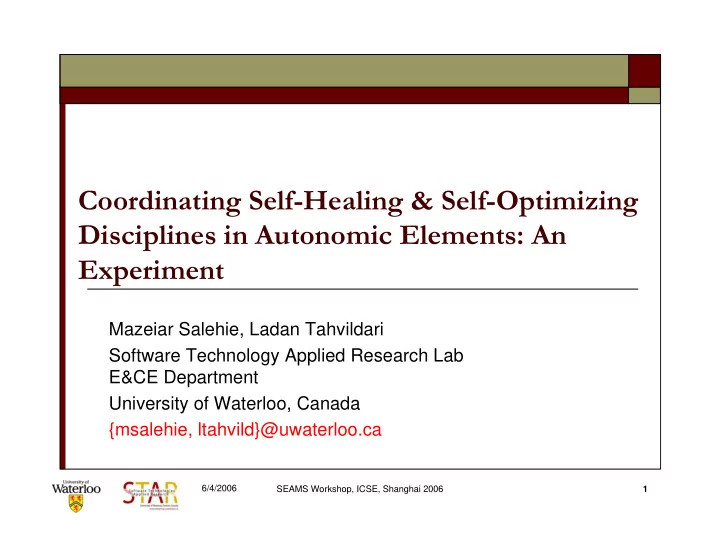

Coordinating Self-Healing & Self-Optimizing Disciplines in Autonomic Elements: An Experiment Mazeiar Salehie, Ladan Tahvildari Software Technology Applied Research Lab E&CE Department University of Waterloo, Canada {msalehie, ltahvild}@uwaterloo.ca 6/4/2006 SEAMS Workshop, ICSE, Shanghai 2006 1
Problem Statement � Self-managing software through self-CHOPs disciplines � Each discipline addresses a different concern of the autonomic element Mostly monitoring and analyzing different information & � symptoms � Mostly using different decision-making methods � Research problem : How to coordinate disciplines with different natures toward a set of goals such as business objectives � Research focus : Coordinating self-healing and self- optimizing at the element level 6/4/2006 SEAMS Workshop, ICSE, Shanghai 2006 2
Self-Healing Discipline � Parameters : � Problem : returning to the previous healthy state (if possible) or going to another healthy state � Solution : Planning especially AI-Planning seems to be appropriate, Probability network 6/4/2006 SEAMS Workshop, ICSE, Shanghai 2006 3
Self-Healing - Actions Action Entity Adaptation Restarting Components, Servers, Weak Adaptation Services Restructuring System, Subsystem, Strong Adaptation Application Redeploying Components, Servers Weak Adaptation Provisioning Servers, Machines Strong Adaptation Weak Adaptation: Modifying/tuning/adjusting parameters, variables or the actions that does not change drastically the system entities. Self-Healing is mostly based on reactive actions Strong Adaptation: Modifying/changing more significant system properties (in case of detecting fault/failure) such as architecture, or adding/deleting entities. 6/4/2006 SEAMS Workshop, ICSE, Shanghai 2006 4
Self-Optimizing Discipline � Parameters : � Problem : Adjusting attributes such as performance, response time and throughput regarding system policy/goals (i.e. QoS) � Solution : Optimization (utility functions), Controlling (feedback & adaptive control methods) 6/4/2006 SEAMS Workshop, ICSE, Shanghai 2006 5
Self-Optimizing Actions Action Entity Adaptation Tuning Generally resources and Weak Adaptation parameters Restructuring System, Subsystem, Strong Adaptation Application Load Balancing Components, Servers, Strong Adaptation Services Provisioning Servers, Machines Strong Adaptation Self-Optimizing is a continuous process with proactive and reactive actions 6/4/2006 SEAMS Workshop, ICSE, Shanghai 2006 6
Coordination Joint Points Change Request Analyze Plan Symptom Change Plan Knowledge Monitor Execute Self-Optimizing Loop Joint Point Self-Healing Loop 6/4/2006 SEAMS Workshop, ICSE, Shanghai 2006 7
Combinations of Adaptation Types Self-Healing Self-Optimizing Weak Adaptation Weak Adaptation Weak Adaptation Strong Adaptation Strong Adaptation Weak Adaptation Strong Adaptation Strong Adaptation 6/4/2006 SEAMS Workshop, ICSE, Shanghai 2006 8
The Experimental Model Autonomic Element Fees, Penalties, etc. Utility Utility Autonomic Manager Measurement Fact/Directive Module Service Response Time Local Policy Level Repository Agreements Web Translating Server Database Server Application Machine n+1 Server Traffic . Machine 1 . . Traffic . . . Generator Web Database Server Server Machine m Application Server Machine n 6/4/2006 SEAMS Workshop, ICSE, Shanghai 2006 9
Implementing Self-Healing & Self-Optimizing � Self-healing Domain model Initial state � Using AI-planning (in ABLE) Goal state � Continuous re-planning Planner � Self-optimizing � Using utility-based fuzzy rules Plan Self + Self + Context Context 6/4/2006 SEAMS Workshop, ICSE, Shanghai 2006 10
A Sample Result http://www.stargroup.uwaterloo.ca/pubs/tech_report/TR-ECE-2006-06.pdf 6/4/2006 SEAMS Workshop, ICSE, Shanghai 2006 11
Summary � Lessens learned Coordinating autonomic disciplines can help autonomic � managers to achieve goals such as business objectives. � Execution-based coordinating seems to be appropriate for weak-strong adaptation action trade-offs for self-healing and –optimizing � Future works � Execution-based coordinating would change the rest of action plan for another discipline. How to update the action plan? � Solutions in strong-strong and weak-weak cases 6/4/2006 SEAMS Workshop, ICSE, Shanghai 2006 12
Coordinating Self-Healing & Self-Optimizing Disciplines in Autonomic Elements: An Experiment Mazeiar Salehie, Ladan Tahvildari Software Technology Applied Research Lab E&CE Department University of Waterloo, Canada {msalehie,ltahvild}@uwaterloo.ca 6/4/2006 SEAMS Workshop, ICSE, Shanghai 2006 13
Recommend
More recommend